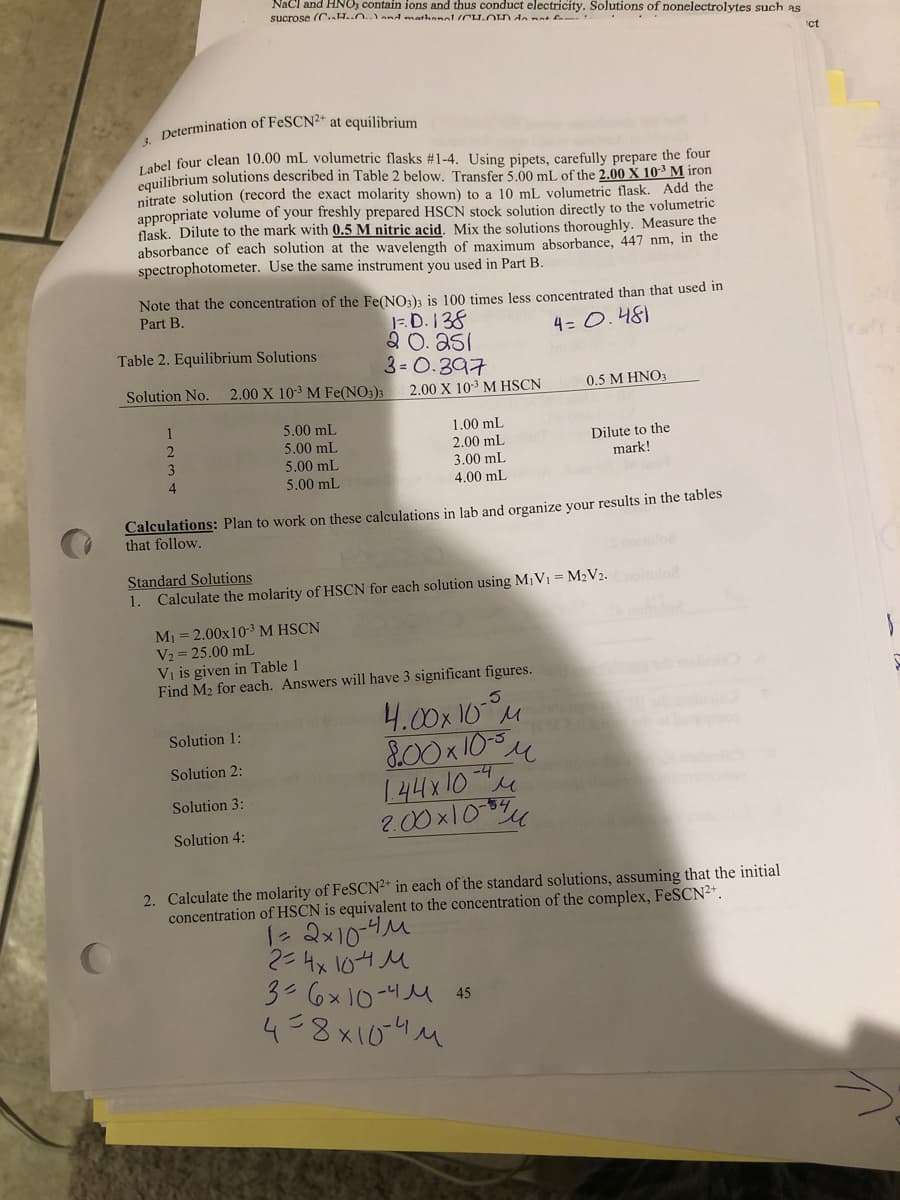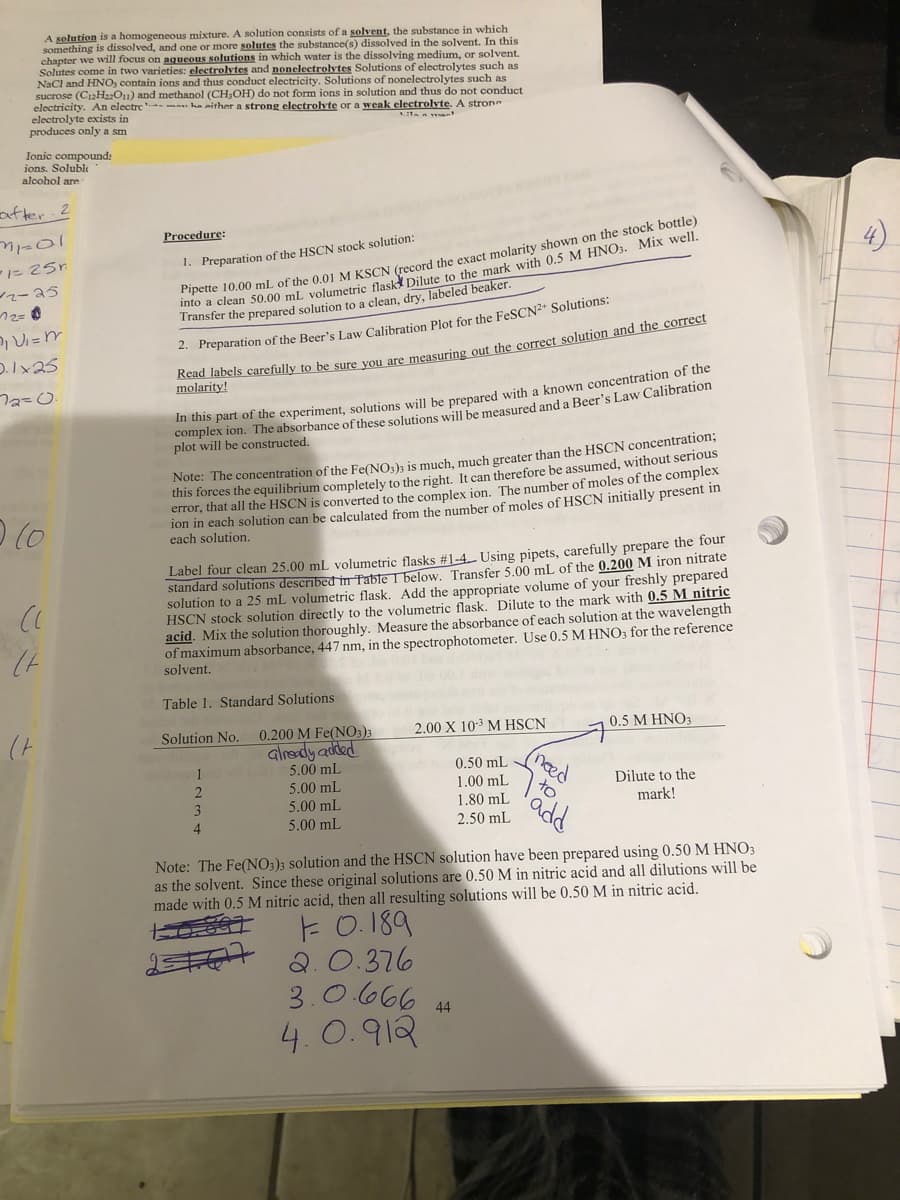2. Calculate the molarity of FESCN²* in each of the standard solutions, assuming that the initial concentration of HSCN is equivalent to the concentration of the complex, FeSCN2+.
2. Calculate the molarity of FESCN²* in each of the standard solutions, assuming that the initial concentration of HSCN is equivalent to the concentration of the complex, FeSCN2+.
Chapter79: Solubility
Section: Chapter Questions
Problem 1P
Related questions
Question
I’m not sure if I did question 2 right. Calculate the molar it you if FeSCN2+

Transcribed Image Text:NaCl and HNO, contain ions and thus conduct electricity. Solutions of nonelectrolytes such as
sucrose (CH..n..) and mathonal (CH.OD de nnt fa
ct
Determination of FeSCN²* at equilibrium
3.
Label four clean 10.00 mL volumetric flasks #1-4. Using pipets, carefully prepare the four
couilibrium solutions described in Table 2 below. Transfer 5.00 mL of the 2.00 X 10-³ M iron
nitrate solution (record the exact molarity shown) to a 10 mL volumetric flask. Add the
appropriate volume of your freshly prepared HSCN stock solution directly to the volumetric
flask. Dilute to the mark with 0.5 M nitric acid. Mix the solutions thoroughly. Measure the
absorbance of each solution at the wavelength of maximum absorbance, 447 nm, in the
spectrophotometer. Use the same instrument you used in Part B.
Note that the concentration of the Fe(NO.)a is 100 times less concentrated than that used in
Part B.
1- D. 138
20. asI
3- 0.397
4= 0.481
Table 2. Equilibrium Solutions
Solution No.
2.00 X 10-3 M Fe(NO3)3
2.00 X 10-3 M HSCN
0.5 M HNO3
1
5.00 mL
5.00 mL
1.00 mL
Dilute to the
2.00 mL
3.00 mL
4.00 mL
3
5.00 mL
mark!
4
5.00 mL
Calculations: Plan to work on these calculations in lab and organize your results in the tables
that follow.
Standard Solutions
1. Calculate the molarity of HSCN for each solution using MIV1 = M2V2.
noiulo
M1 = 2.00x10-3 M HSCN
V2 = 25.00 mL
Vị is given in Table 1
Find M2 for each. Answers will have 3 significant figures.
4.00x 10 M
&00 x 10-5
144x10
2.00x106%
Solution 1:
Solution 2:
-4
Solution 3:
Solution 4:
2. Calculate the molarity of FeSCN²* in each of the standard solutions, assuming that the initial
concentration of HSCN is equivalent to the concentration of the complex, FeSCN²+.
1- 2x10-4M
2-4x 104 M
3-6x 10-4 M 4s
4=8x104M

Transcribed Image Text:A solution is a homogeneous mixture. A solution consists of a solvent, the substance in which
something is dissolved, and one or more solutes the substance(s) dissolved in the solvent. In this
chapter we will focus on aqueous solutions in which water is the dissolving medium, or solvent.
Solutes come in two varieties: electrolytes and nonelectrolytes Solutions of electrolytes such as
NaCl and HNO, contain ions and thus conduct electricity. Solutions of nonelectrolytes such as
sucrose (C12HO1) and methanol (CH,OH) do not form ions in solution and thus do not conduct.
electricity. An electrc---m ha mither a strong electrolyte or a weak electrolyte. A stron
electrolyte exists in
produces only a sm
an an
Ionic compound:
ions. Soluble
alcohol are
after 2
Fipette 10.00 mL of the 0 01M KSCN (record the exact molarity shown on the stock bottle)
clean 50.00 mL volumetric flaskt pilute to the mark with 0.5 M HNO3. Mix well.
Transfer the prepared solution to a clean, dry, labeled beaker
Procedure:
1. Preparation of the HSCN stock solution:
マー35
meledocis carefully to be sure you are measuring out the correct solution and the corect
molarity!
2. Preparation of the Beer's Law Calibration Plot for the FeSCN" Solutions:
D.1x25
complex ion. The absorbance of these solutions will be measured and a Beer's Law Calibration
plot will be constructed.
Note: The concentration of the Fe(NO:)a is much, much greater than the HSCN concentration;
this forces the equilibrium completely to the right. It can therefore be assumed, without serious
error, that all the HSCN is converted to the complex jon. The number of moles of the complex
ion in each solution can be calculated from the number of moles of HSCN initially present in
each solution.
Label four clean 25.00 mL volumetric flasks #1-4 Using pipets, carefully prepare the four
standard solutions describedin fable I below. Transfer 5.00 mL of the 0.200 M iron nitrate
solution to a 25 mL volumetric flask. Add the appropriate volume of your freshly prepared
HSCN stock solution directly to the volumetric flask. Dilute to the mark with 0.5 M nitric
acid. Mix the solution thoroughly. Measure the absorbance of each solution at the wavelength
of maximum absorbance, 447 nm, in the spectrophotometer. Use 0.5 M HNO3 for the reference
solvent.
Table 1. Standard Solutions
Solution No.
0.200 M Fe(N03)3
2.00 X 103 M HSCN
0.5 M HNO3
alnedy added
5.00 mL
0.50 mL
1.00 mL
1.80 mL
noed
to
1
5.00 mL
5.00 mL
Dilute to the
mark!
3
4
5.00 mL
2.50 mL
Note: The Fe(NO3)3 solution and the HSCN solution have been prepared using 0.50 M HNO3
as the solvent. Since these original solutions are 0.50 M in nitric acid and all dilutions will be
made with 0.5 M nitric acid, then all resulting solutions will be 0.50 M in nitric acid.
E 0. 189
2.0.376
3.0.666
4.0.912
44
Expert Solution
This question has been solved!
Explore an expertly crafted, step-by-step solution for a thorough understanding of key concepts.
This is a popular solution!
Trending now
This is a popular solution!
Step by step
Solved in 2 steps with 2 images

Knowledge Booster
Learn more about
Need a deep-dive on the concept behind this application? Look no further. Learn more about this topic, chemistry and related others by exploring similar questions and additional content below.Recommended textbooks for you

EBK A SMALL SCALE APPROACH TO ORGANIC L
Chemistry
ISBN:
9781305446021
Author:
Lampman
Publisher:
CENGAGE LEARNING - CONSIGNMENT


Principles of Modern Chemistry
Chemistry
ISBN:
9781305079113
Author:
David W. Oxtoby, H. Pat Gillis, Laurie J. Butler
Publisher:
Cengage Learning

EBK A SMALL SCALE APPROACH TO ORGANIC L
Chemistry
ISBN:
9781305446021
Author:
Lampman
Publisher:
CENGAGE LEARNING - CONSIGNMENT


Principles of Modern Chemistry
Chemistry
ISBN:
9781305079113
Author:
David W. Oxtoby, H. Pat Gillis, Laurie J. Butler
Publisher:
Cengage Learning